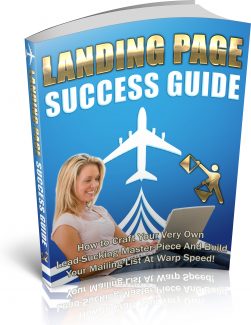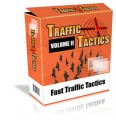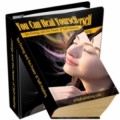 License Type: Private Label Rights
License Type: Private Label Rights  File Type: ZIP
File Type: ZIP
 SKU: 62160
SKU: 62160  Shipping: Online Download
Shipping: Online Download
Sample Content Preview
Introduction to Landing Pages
Before you begin the attempt to build a successful list or create a powerful sales page, you will want to start with a rigorous introduction to landing pages. In stark contrast to undifferentiated, unfocused home pages, landing pages focus specifically on capturing leads for a newsletter or making sales for a specific product – and make no attempt to give visitors a different option.
Another common word that is often used to describe landing page, is “squeeze page” (or “lead capture page” in some circles). A squeeze page is a page designed to get names and email addresses. Usually, however, a squeeze page is usually a smaller type of landing page, which usually has an opt-in form in sight when the page loads.
So what is important to learn in an introduction to landing pages? First, it is important to recognize that all successful marketers use these. If you plan to sell a product over the Internet, you will want to use one, too, rather than relying on sidebar opt-in forms and unfocused pages that do not convey a single point and a single call to action.
Another important thing you will want to take away from this introduction to landing pages is that every landing page contains the same parts and is focused on a SINGLE goal – getting the visitor to become a subscriber or buyer.
These parts are as follows: an opt-in form (or sales prompt), a brief or lengthy introduction, a picture of the list/product owner, the signature of the list owner, and a call to action (or multiple calls to action).
Determining which model will work best for you can simply only be done through testing. While many boast a conversion and attribute it to the shortness of their introduction (many will be one short paragraph), otherwise will boast a high conversion rate because they use lengthy, thorough, and compelling copy.
If there is anything you absolutely must take away from an introduction to landing pages, it is that you cannot create a landing page or squeeze page that isn't focused.
The Landing Page System
The landing page system provides a uniquely powerful system through which you can derive profit from multiple streams. This article will briefly discusses some of those different streams – and how you can manipulate them.
Let's start with the landing page itself: all traffic is sent to the landing page. From there, it will have a number of options, depending on what you have given them. Many marketers suggest that your landing page should always be an opt-in form. Others will suggest that it should simply be a sales page.
Whether it's a free newsletter or a product for sale, the landing page system you create should include a “one time offer,” which will compel them to take action – subscribe, buy, etc.
Once they subscribe or buy, the landing page system you create should then re-route them to a thank you page, which opens up more means through which you can up-sell. One quick way to up-sell is to simply include advertisements on your thank you page for related affiliate products or for your own products. Here, again, you will want to give them a one-time offer.
Also, if you haven't yet asked them to join your mailing list, this is where you should do it – on your thank you page. Once they opt-in to your list, you now have a whole new option you can use in conjunction with the landing page system to generate revenue.
One such option is selling ad space in your newsletter or e-zine. The more people you have reading your newsletter, the more you can generally charge for ad space; however, you will want to avoid overselling to your list to ensure your advertisers actually make money.
Your next option is to endorse a product as an affiliate. You can tell your subscribers how someone has just created a brilliant product – and you can offer it to your subscribers through an affiliate link. You may even want to use other products you have has bonuses to give them something extra.
The last and most profitable way in which you can generate revenue through your newsletter is by creating and selling your own products to them.
It is important to note that you don't have to use all of these means to generate revenue; however, the more you use, the more you earn in general.
Your Landing Page
Your One Time Offer (OTO)
Subscription to your Mailing List Sell Ad Space in Your eZine Endorse as an Affiliate
Thank You Page
Back-end Ads & Selling
Sell your own product
What You Need Before Getting Started
Before you get started building your landing page, you will need a number of things to a) make your offer actually have a point; and b) facilitate the creation of your landing page.
One thing you absolutely must have before you get started is an auto responder. Without any auto responder, you are tossing potential bags of money in the garbage. Rather than creating a relationship with customers and potential customers – and giving yourself the opportunity to attempt future up-sales -- you're allowing them to leave and never return.
In addition to an auto responder, you will need to have an actual offer that people want to buy. You may want to develop a product, such as an E-Book or a piece of software.
If you don't have the skills to do either, you can always hire a professional to do it for you through Elance.com or Guru.com. You will then either want to sell this product and attempt to get subscribers from your thank you page – or you will want to get subscribers by offering the product for free (which is what many Internet marketers now do).
Another thing you absolutely must have before you get started is a check out service. You may want to consider Paypal, Click Bank, or 2 Check Out. All of these services will allow you to make transactions quickly.
Another thing you must have before you get started is a set of graphics, which usually includes a graphic header, a check out button, background wallpaper, and a half-decent picture of yourself. You can probably provide the picture of yourself, but you might want to hire a professional to do the rest.
Another thing you will need before you can get started on your landing page is some way in which to create a realistic signature. http://www.vletter.com is probably your best bet; but, if you're on a budget, you may want to opt for simply using a word processing program.
Planning Your Landing Page Theme
Perhaps the most important part of creating a landing page is planning your landing page theme. How you select your theme, of course, will all depend on how you plan to generate traffic.
If you decide to generate traffic through search engine optimization, planning your landing page theme will entail finding phrases within your niche which have a high demand (aggregate search value) and a low supply (small amount of competing sites) and then creating multiple landing pages, each which is optimized around a different phrase.
If, on the other hand, you decide to generate traffic through pay per click (PPC) programs, such as Adwords, planning your landing page theme will again entail tuning a number of different pages to fit the keywords you are purchasing.
This is actually where most people fail when they create a landing page: they don't tune it to fit a specific audience. For instance, in the case of a squeeze page for a newsletter, they might start a newsletter about toys, but they only create one landing page and send all traffic to it. This is a big mistake.
Chances are, if you create a quality product or newsletter, it can benefit a number of people. So why not communicate the exact benefits they will derive from subscribing or buying?
If, for instance, you have a newsletter about Legos and toy blocks, so you group it under the loose heading of “toys,” a visitor who is looking specifically for information about either Legos or toy blocks will click off your page if they don't see the direct connection to the exact topic for which they were searching.
Instead, you will want to setup a page centered around Legos and a page centered around toy blocks. On each page, you will want to communicate the specific benefits to joining the list for each of those groups of visitors.
- License: Private Label Rights
- Category:Ebooks
- Tags:2018 Ebooks Private Label Rights








